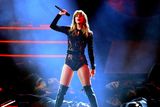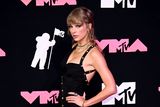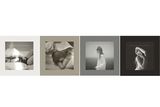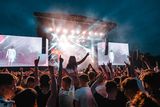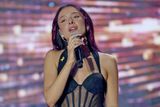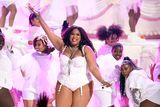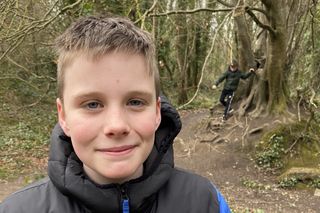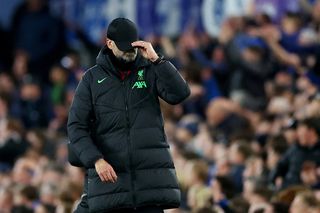Yeah, yeah, yeah! Rare footage of The Beatles' Dublin performance
Classic, rare and never-before-seen: from the Irish Independent Photo Archive comes newly unearthed pictures of the magical night in 1963 when The Beatles stormed Dublin.
Thursday, November 7, 1963 will always be etched on the hearts of a small number of Irish people who were then teenagers, now past retirement age. It was the day a Liverpool four-piece with one album and a couple of singles came to town and played two gigs in a Dublin cinema. They were already on their way to stardom, and in time would become the biggest selling and most influential band in the history of popular music.
Dublin had never seen anything like the Beatles, and the excitement was too much for the city.
"Dublin Gardaí battle with Beatles fans", ran the headline in the next day's page one story in the Irish Independent. It told of cars being damaged and a number of people receiving injuries, "as teenage crowds pressed on the Adelphi Cinema, Middle Abbey St, last night, where the Liverpool vocal group, The Beatles, was making its first appearance in the country."
The reporter told of crowds chanting, "We want the Beatles", and of 50 gardaí pushing the crowd towards O'Connell Street. An "unruly section" of the crowd resisted and began overturning parked cars. A further 200 gardaí were drafted in and St John's Ambulance assisted several girls who fainted. At least a dozen young men were taken into custody.
But for all the bad news there were thousands of young people who made their way home that night with a permanent grin on their face and a sparkle in their eyes. These fans had witnessed a concert that would go down in musical history. As that "Liverpool vocal group" went on to conquer the world, they would never again return to play in Ireland.
The gig had been announced in the Tempo column in the Evening Herald early in October. Tickets went on sale priced at six shillings and six pence, 8/6 and 10/6 (set against the threepence cover price of the Irish Independent, in modern money that would come to €52, €68 and €84).
The Beatles had been making waves for little more than 12 months, and had their first No 1, Please, Please Me, in spring that year. Their second album was about to hit the shops and She Loves You was on the top of the charts. The newspapers weren't sure what to make of this phenomenon, and braced for trouble, with incidents of "rowdy" fans at gigs in England being reported here.
After a 90-minute flight from London, the Aer Lingus Viscount EI155 touched down just after noon on November 7. A number of fans were there to greet them, their shrieks carrying across the tarmac from the viewing platform on the roof of the old Collinstown terminal. Down the steps tripped the young men - the oldest of whom, Ringo Starr, was just 23.
They were greeted by PR man Paul Russell, who was a mover-and-shaker on the Dublin scene, and showbiz reporter Frank Hall who had an RTÉ camera crew in tow. It was the start of a hectic day in the city for the band who, even in private, were rarely without a microphone hanging on their every word.
One of the first of those words was "flabbergasted", which they gave as their reaction to the success which had come their way. George Harrison also explained how he would spend his time in the city checking in on relations in Drumcondra and Dun Laoghaire.
Duties performed, the band got a lift into the city in the flashy Chrysler Saratoga owned by Russell, who was the son of a Kerry GAA legend of the same name who, at 17, was the youngest man to win an All-Ireland senior medal. He dropped them to the Gresham Hotel in O'Connell Street just before 2pm.
There they recorded an interview for the Showband Show - for a fee of £5 - in the hotel's ballroom but pre-gig giddiness meant they spent most of the time messing around and making faces for the cameras.
About 4pm they headed across to the Adelphi on Middle Abbey Street to prepare for the first of two back-to-back shows at 6.30pm. They also hosted what must have been one of the most glittering press conferences ever seen in the city, even if it didn't seem like it at the time.
The poet Patrick Kavanagh was there, gathering material for a column in the RTV (later RTÉ) Guide. He wandered around telling people how he disliked the Beatles, although some time later admitted he was a fan. In the magazine he bemoaned how no similar local band had emerged: "So far the Irish have not produced a guitaring ensemble of sufficiently outrageous codology. I saw the Clancy Brothers on the television and they hadn't that final touch of nerve and neck which is required."
Also present was Donal McCann, later a leading actor, but in 1963 a copyboy in the Irish Press. Just 16 years old, McCann threw Lennon a curveball when he asked did he believe there was a God. After a long pause, during which the Beatle conferred with playwright Alun Owen, he replied that he had "certain reservations" but the newspaper refused to print that answer. Had it done so it might have derailed the band which was yet to break America. Three years later Lennon said the band was "bigger than Jesus", causing a furore in the US.
Owen was in Dublin to research the band for a project he was working on - their first movie A Hard Day's Night.
Another future legend also showed up at the press conference. On the coat-tails of his big sister Lyn who gate-crashed the event, he was a 12-year-old Dublin schoolboy called Bob Geldof.
Once the media had their fill, the band slipped away to their dressing room and readied themselves for the first show, which began at 6.30pm. Concerts of that era were elaborate affairs with several performers, and the Beatles were just the headliners on a bill that also included the Brook Brothers, Peter Jay and the Jaywalkers, Vernons Girls and The Kestrels.
The Adelphi was a landmark in Dublin, and the premier concert venue since the closure of the Theatre Royal the year before. While primarily a cinema, throughout the 1960s it hosted gigs by the Rolling Stones, Diana Ross and the Supremes, Bob Dylan, the Beach Boys, Johnny Cash and many more, as well as President John F Kennedy who attended a party there in 1963.
Donal McCann, showing a lyrical flourish belying his youth, wrote of the minutes leading up to the top-billers' appearance:
"The atmosphere was hot and sharp; full of powder and perfume and a frightening excitement. They screamed at the pictures in their programmes, or if someone shouted 'Beatles' they screamed - long, loud screams that cut through the heavy air. The house erupted into one mad, thunderous piercing noise that it would be impossible to forget."
Just before the curtains opened the first chords rang out of I Saw Her Standing There and the screams started again. They played just nine more songs: From Me To You, All My Loving, You Really Got A Hold On Me, Roll Over Beethoven, Boys, Till There Was You, She Loves You, Money and Twist and Shout. It was all over in 25 minutes.
The idea of holding two gigs on the same night made economic sense to the promoter and the bands, but the layout of the venue meant the evening descended into chaos. Just as the 2,304 satisfied customers from the first show streamed out into Middle Abbey Street, they were met by a similar number eagerly awaiting the 9pm performance. And an estimated 2,000 who had come along without tickets hoping for a glimpse of the band.
According to Colm Keane's marvellous book The Beatles Irish Concerts which was published in 2008, "At its peak, some 7,000 bodies were crammed together into Middle Abbey Street, forming a heaving, swaying, agitated, panicking mass. The scene was a potential disaster. It was like an accident slowly unfolding, a catastrophe waiting to happen."
The crowd were spared disaster, although three young people were treated in nearby Jervis Street hospital for broken limbs. Bizarrely, with crowds still milling around, John and Ringo decided to brave the street just after the start of the second show, nipping out in disguise with two of The Kestrels because of their urge to sample Guinness in its native city. They scooted into The Oval bar beside the side entrance to Eason's and escaped without being recognised.
The second gig ended just before 11pm, but the crowds would not leave the street, desperate to catch sight of the band or maybe hustle an autograph. Crowd-control techniques were rudimentary at the time, and crash barriers had yet to be invented.
"It was frightening," one fan told Keane. "You were caught in this situation where people were still pushing towards the theatre and others were trying to get out. The guards were pushing people aside to try and clear the way."
But the fans' efforts to meet the Beatles were fruitless, as they had left the venue within a minute of the end of their performance.
The Adelphi's charismatic manager, Harry Lush, had seen what was happening and rang the Irish Independent for assistance. The newspaper group's premises was next to the Adelphi and both back entrances led on to Princes Street, beside the GPO. A delivery van was secured and the band bundled into the back where they sat on makeshift seats made from stacks of newspapers.
Independent reporter John Healy was there to meet them, and get the exclusive: "They were very frightened. They knew if they didn't get out this way, they'd be torn to bits. They were actually pale coming out. They didn't have an awful lot to say." One of the band gushed, "We knew we'd get a good reception, but we didn't think we'd get this reception, unbelievable reaction".
Driven by Jack Flanagan, the van sped down O'Connell Street and deposited the group at the back entrance to the Gresham.
The next day Kelly explained the dramatic exit: "With the precision of a commando operation and within 10 musical beats of their closing number - Twist and Shout - the Beatles were whisked to the safety of their hotel in an Evening Herald delivery van last night."
The crowds continued to congregate outside the Gresham but with the last CIE buses leaving the city centre at 11.30pm the teenagers drifted away with nothing but memories. The band remained in the hotel foyer chatting before heading up the street for some late pints. Groome's Hotel, which was directly across Cavendish Row from the entrance to the Gate Theatre, was a favourite haunt of the actors who were performing in the musical Carrie. Its author Wesley Burrowes - later famous as creator of RTÉ agri-soaps The Riordans and Glenroe and who passed away recently - was drinking with the cast.
He told Colm Keane: "We had a wee girl with us in Carrie who used to be in The Riordans as well. George Harrison came over to her and asked her would she like to dance. She told him to 'shag off'! Afterwards when she realised who it was and what she had just turned down she was very mortified."
The band packed up next morning and headed up to Belfast for another memorable gig, their last on Irish soil.
Three months later they flew to the US for the first time and their fame and selling power reached levels never seen before or since. They continue to sell well, with 1, the compilation of the band's best-selling singles, hitting No.5 just before Christmas. In all they are estimated to have sold more than 600 million records.
Two of the band are dead, John Lennon at the hand of a deranged gunman in 1980 and George Harrison to cancer in 2001. Paul McCartney continues to record and has performed several times in Dublin, most recently in 2010. Ringo Starr is also still musically active but is better known to modern youth as the narrator of the Thomas the Tank Engine TV series.
At the end of the 1960s the Adelphi closed for a year for alterations which split its huge auditorium into three screens and ended its era as a concert hall.
The cinema closed for good in 1995 and is now Arnotts' car park. The stylish art-moderne façade is retained and cars drive in and out what was the grand entrance through which once walked John, Paul, George and Ringo.
The photos on these pages have only recently come to light after being lost for more than 40 years. Taken on the night of November 7, 1963, some of the photos were used in the Irish Independent and Evening Herald at the time but at some stage they were misfiled among the millions of negatives and prints in the newspaper group's collection.
Editorial imaging manager Michael Hinch worked for the Irish Independent for 46 years, retiring last autumn. In 2005 he oversaw the handover of the 4.5million images in the Independent's files to the National Photographic Archive (NPA).
Last summer I was putting together the supplement on the centenary of the sinking of the Lusitania, and arranged to meet Michael in the NPA in Temple Bar. As I examined the glass plate negatives of that tragedy, he busied himself searching for photos of the 1976 Irish Sweeps Derby.
Riffling through the boxes from that year, and picking out some of the 35mm negatives for further examination, he was puzzled by some 2¼-inch square negatives which were out of place. "Being inquisitive", he recalled, "I took another look. The first ones I looked at were of gardaí and a crowd of young people."
I heard him let out a yelp.
It was a magical moment, in its own small way akin to how Howard Carter must have felt as he opened Tutankhamun's tomb. Michael's eyes widened, and he beckoned me over to a lightbox.
"Who's that?" he asked me, looking for confirmation.
"I think that's… Paul McCartney?" I offered.
"I've never seen these before…" he whispered, his eyes shining brightly. The photos had been often talked about, and sought, in the years since.
"Everyone thought they had been lost. To find them was just brilliant, I was gobsmacked," he said this week.
More and more negatives tumbled out of the box, emerging as these fascinating photos of that amazing night the Beatles played, and the excitement just got too much for many Dubliners.
* Independent Archives is offering Weekend readers an exclusive 10% off all prints this weekend. Go to independentarchives.com and use the code BEATLES10 at checkout to avail of this offer, with free worldwide delivery included.
Offer valid February 6 and 7, 2016.
From the archives
Join the Irish Independent WhatsApp channel
Stay up to date with all the latest news
